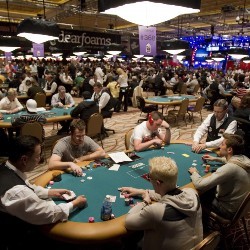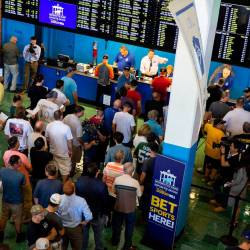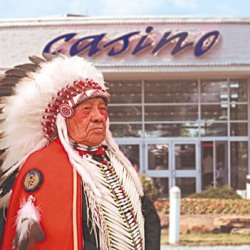Nevada’s Poker Rooms Declining Since 2007

When you walk into a casino today, it’s natural to find players sitting at dedicated poker tables while the dealer shuffles and doles out the cards. In fact, the sight is so commonplace that it’s hard to imagine modern gambling without poker having a place in it, but new numbers published in a study from the UNLV Center for Gaming Research show that poker was on its way out in the early 2000s, and might have been eliminated from casinos entirely had the ‘Moneymaker Effect’ and online poker not come to its rescue.
Data from the Study
Statistics published by the UNLV Center for Gaming Research show that the number of poker tables in Las Vegas declined by 40 percent between 1992/93 and 2002/03. Because casinos assign tables to games based on player interest, this shows that the game’s popularity was steadily dwindling. While there were a few upswings during the decade, with increased table numbers in 1994 and 1999, analysts credit those positive changes with renewed interest in the game brought about by poker legalization in Atlantic City in 1993, and Connecticut in 1995, as well as the resurgence in the popularity of card rooms in California. With more people playing poker in other states, there was renewed interest in playing poker in Las Vegas, although overall, poker was less appealing to casino goers than other games.
Moneymaker Effect
Today, one of the biggest arguments casino owners make against legalizing online poker is that websites hurt the bottom-line of brick and mortar card rooms and casinos. They state that if people can just play poker on their computers or mobile devices, they’re less likely to come to a real life table to play. When you study the numbers provided by the University of Nevada Las Vegas, you get a different picture of how online poker affects casino poker play.
In 2003, Chris Moneymaker gained celebrity by winning the World Series of Poker Main Event and many who tuned in to watch the tournament subsequently became interested in playing the game themselves. They started using online poker sites to practice and get more comfortable competing against opponents, and with the new confidence online poker players gained, they were soon more willing to try their skills at land-based casinos. As a result, while poker tables being offered in Las Vegas increased by 18.15 percent in 2003, by 2004 and 2005 the number of tables rose by an impressive 44.8 and 42 percent, respectively.
Other Contributing Factors
It’s clear that online poker helped to give casino poker the boost it so badly needed, but there were some other factors that contributed to renewed interest in the game. The movie Rounders and the book Positively Fifth Street made college students and executives alike keen to play the game, while the hole card camera used at televised World Series of Poker events helped spectators to learn some of the winning strategies used by the pros. All in all, the early 2000s became the prime time for people to play poker, with the boom continuing until 2006, when the UIGEA was introduced. When you examine the historical numbers, it’s easy to imagine now that the expansion of legal online poker to other states other than just Nevada, Delaware, and New Jersey could once more help stimulate interest in the game at casinos in Vegas, and beyond.
Nevada Poker Generates $118M in 2015
In 2015, Nevada’s poker rooms generated $118 million in revenues, down from the $120 million collected in 2014, and $123.9 million in 2013. These figures are down from an all-time high of $168 million in 2007, with revenues having fallen in every consecutive year, with the exception of the slight 0.56% uptick in 2013, the year online poker was launched in the Silver State.
Nevada Poker Revenues in 2015:
January: $9.78m
February: $8.53m
March: $9.69m
April: $8.51m
May: $10.32m
June: $15.84m
July: $11.45m
August: $8.51m
September: $8.34m
October: $8.73m
November: $8.97m
December: $9.36m
Nevertheless, poker is not the only gambling game to experience declining fortunes, and currently casino game revenues represent just 43% of the money generated by Nevada’s 271 casinos, which is a significantly lower percentage than in previous years. This points to a contracting interest in visiting Las Vegas solely for gambling purposes, and these days large casino operators, such as MGM Resorts and Caesars Entertainment, ensure their establishments offer a full range of food, and other forms of entertainment to cater for the changing tastes of their customers.







